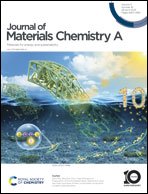Promoting osmotic energy conversion through fluorinated nanochannel membranes with large-scale exfoliation and low transmission resistance†
Abstract
Two-dimensional (2D) nanofluidic channels open up exciting possibilities for harvesting blue osmotic energyfrom salinity gradients. Current efforts to improve osmoticenergyconversion are mainly based on increasing the charge density of nanochannels. Here, a novel strategy to harvest osmotic energy by utilizing strongly electronegative CF3 to reduce hydrated ion transport resistance in a reconstructed clay nanosheets-based membrane is proposed.The high-quality monolayered clay nanosheets are prepared by large-scale exfoliation at room temperature withslightstirring. Theexfoliation time is only 3 min, which is 97.5% shorter than that of the fastest time reported by others. Moreover, the exfoliation concentration reaches up to 70 phr at room temperature, which is a 2.5-fold improvement over the previous highest value. The CF3-fluorinated claymembrane with thefeature of breaking water clusters possesses significantly reduced transmission resistance and increased surface charge density, thus achievinghigh cation selectivity and output power density up to 4.10 W m−2 in an artificial sea-river water system. This economically viablestrategy may advance the industrialization process ofultrathin 2D nanosheets preparation and osmotic energy harvesting.



 Please wait while we load your content...
Please wait while we load your content...